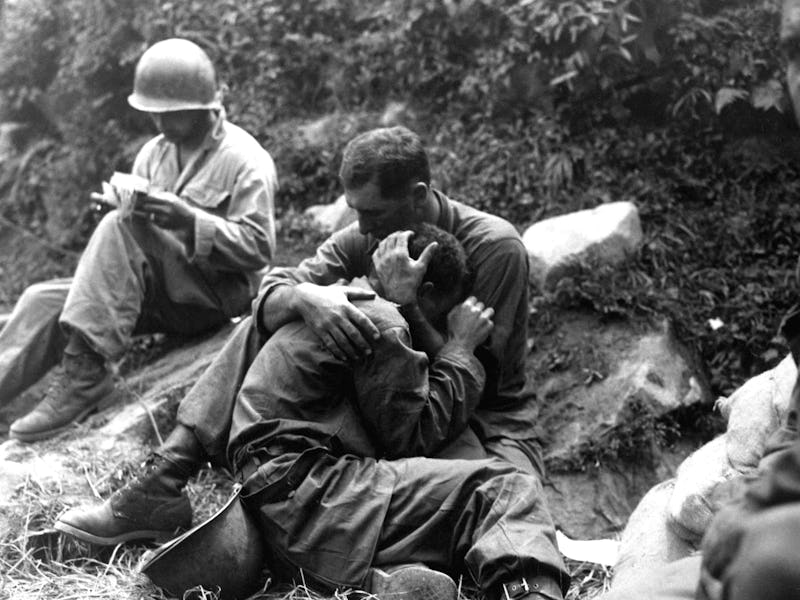People Who Give Up on Life Can Die From "Psychogenic Death," Say Scientists
"Finally they 'turned their faces to the wall' and died."

On April 30th 1954, Major Henry A. Segal, a medical officer in the US Army authored a report to a describing a strange “syndrome” that plagued the prisoner of war camps during the Korean War. The men stopped eating, would only consume cold water, and stopped talking about the future. They were simply waiting to die.
“With the passage of time, they withdrew more and more from all contacts and became mute and motionless,” the report read. “Finally they ‘turned their faces to the wall’ and died. From the onset of first symptom to demise took a period of 3 weeks, ‘almost to the day’.”
Segal, eventually termed this syndrome “give-up-itis.” John Leach Ph.D., a visiting senior research fellow at the University of Portsmouth in England and a former military psychologist typically calls it “psychogenic death” but admits that “give-up-itis” is bitingly accurate:
“Basically it’s a horrible term” Leach tells Inverse. “But it’s a descriptive term. There were always those people who just gave up — curled up, laid down and died. In many cases these were otherwise healthy men and women, and the thing that stood out was that their death was basically inexplicable. But it appears that there’s an underlying organic cause for it.”
Leach recently released a paper that suggests a potential explanation for what goes on in our brains when we cascade into life-threatening hopelessness. Though this disease might look like depression at the outset, Leach says, but he thinks that there’s actually a separate brain mechanism behind it — making it an entirely different condition.
The Feeling of No Escape
Leach has yet to test his hypothesis with clinical trials or brain scans, so his analysis rests upon finding commonality between historical accounts, interviews with survivors of traumatic events (prisoners of war, plane-crash survivors etc.), and psychological diagnoses. Together, he suggests that give-up-itis is a dangerous manifestation of the brain’s survival instinct gone awry.
Leach's model focuses on the anterior cingulate cortex to explain give-up-itis
This process begins with that feeling that all is lost — similar to what it might feel like when you know the ship is going down, and you’re trapped below deck. Past animal studies have suggested that the brain reacts to this by releasing a large amount of dopamine, strangely, a neurotransmitter usually plays a role in the brain’s reward system.
“What happens is if you face a stressful or life-threatening situation there is a boost in dopamine production in the anterior cingulate circuit. And then once that situation is removed or you escape from it that dopamine is lowered,” Leach explains. But soon after that spike, another brain mechanism steps in attempting to stem the flow of the neurotransmitter.
“If that stressful situation continues, then the pre-fronal cortex inhibits dopamine production, and reduces that to a level that is below normal,” he continues. “If you have dopamine down motivation in that circuit, you start to see the types of behavior that are recorded in cases of give-up itis.”
Five-Step Progression
Leach explains that that low production of dopamine is likely responsible for the progression of symptoms that he noticed while combing through tales of atrocities from Korea to early British colonies at Jamestown. His paper suggests that as levels of dopamine drop patients would present with five stages of symptoms.
First, patients tend to withdraw from peers —like the soldiers in Korean POW camps who “remained supine within the confines of their prison hut” according to Segal’s report. Then came apathy, or an an unwillingness to bathe or get dressed — which he noticed in the stories of many concentration camp survivors during World War II in addition to the Korea accounts.
Paratroopers from the 187th Airborne preparing to deploy in 1951
The third step in Leach’s model actually already has a clinical name, aboulia, described as a clinical absence of willpower or the inability to act decisively. Other papers, in addition to Leach’s indicate that this is sometimes followed by akenesia, a syndrome usually seen in advanced Parkinson’s patients who eventually lose the ability to move voluntarily.
Leach has based these five categories off of historical case studies, and observations from a series of papers that have linked them to dopamine disregulation in the brain. But where his model is different is that he groups them together as the progression of a single syndrome, give-up-itis.
“I think what we’re looking at here is a single spectrum, not single categories,” he says. “If you get small drop in dopamine levels then you get demotivation and deapathy. The more dopamine levels fall, more intense the symptoms are that you’re seeing.”
Leach’s paper reads somewhere between a history lesson and a scientific paper, and he admits that he’ll need to test this model to confirm it. But he’s also aware of the delicate nature of this research. Confirming this work will likely requite people to relive intense trauma, or require the cooperation of people that are undergoing tragedy, both tall orders in themselves.
But in the meantime he’s excited by the potential of his model, which is poised to answer questions that were posed over fifty of years ago.
“The question I should have been asking was why did so many people die when there was no need for them to die,” he says. “It was the elephant in the room that wouldn’t go away.”